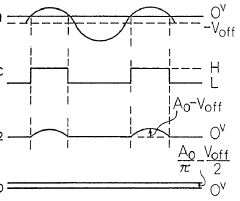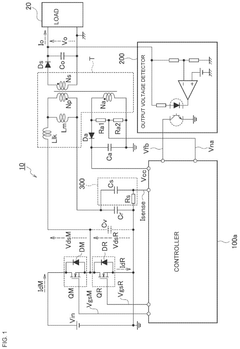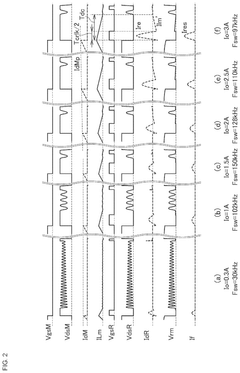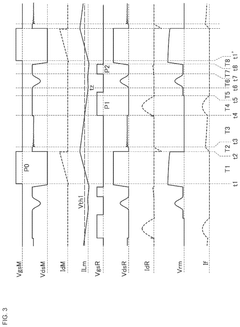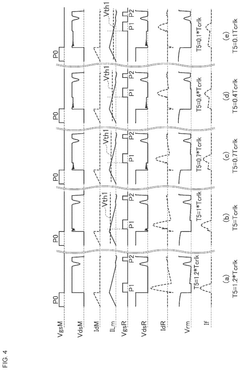How to Overcome Limitations in Half Wave Rectifiers?
JUL 16, 202510 MIN READ
Generate Your Research Report Instantly with AI Agent
Patsnap Eureka helps you evaluate technical feasibility & market potential.
Half Wave Rectifier Background and Objectives
Half wave rectifiers have been a fundamental component in power electronics since the early days of electrical engineering. Developed in the late 19th century, these devices played a crucial role in converting alternating current (AC) to pulsating direct current (DC). The evolution of half wave rectifiers has been closely tied to the advancement of semiconductor technology, particularly with the introduction of diodes.
The primary objective of half wave rectification is to convert AC to DC by allowing current flow in only one direction during each cycle of the AC waveform. This process, while simple in concept, has been the subject of continuous improvement efforts aimed at enhancing efficiency and reducing limitations. The technology has progressed from early vacuum tube rectifiers to modern solid-state devices, each iteration bringing incremental improvements in performance and reliability.
Despite their widespread use, half wave rectifiers face several inherent limitations that have driven ongoing research and development. These limitations include low efficiency, high ripple content in the output, and poor utilization of transformer capacity. The inefficiency stems from the fact that only one half of the AC cycle is utilized, effectively wasting half of the input power. This not only results in lower output power but also introduces significant ripple in the DC output, necessitating additional filtering components.
The technical goals in overcoming these limitations have been multifaceted. Researchers and engineers have focused on improving the overall efficiency of the rectification process, reducing the ripple content in the output DC voltage, and maximizing the utilization of input power. These objectives have led to the exploration of various circuit configurations, the development of more advanced semiconductor materials, and the implementation of sophisticated control strategies.
Another key area of development has been the integration of half wave rectifiers with other power electronic components to create more complex and efficient power conversion systems. This has included the development of voltage multiplier circuits, which use half wave rectifiers as building blocks to achieve higher DC voltages, and the exploration of synchronous rectification techniques to reduce power losses.
The evolution of half wave rectifiers also reflects broader trends in electronic miniaturization and energy efficiency. As electronic devices have become smaller and more portable, there has been a growing demand for compact, high-efficiency power conversion solutions. This has driven research into novel materials and circuit designs that can operate at higher frequencies and with lower losses, pushing the boundaries of what is possible with half wave rectification technology.
The primary objective of half wave rectification is to convert AC to DC by allowing current flow in only one direction during each cycle of the AC waveform. This process, while simple in concept, has been the subject of continuous improvement efforts aimed at enhancing efficiency and reducing limitations. The technology has progressed from early vacuum tube rectifiers to modern solid-state devices, each iteration bringing incremental improvements in performance and reliability.
Despite their widespread use, half wave rectifiers face several inherent limitations that have driven ongoing research and development. These limitations include low efficiency, high ripple content in the output, and poor utilization of transformer capacity. The inefficiency stems from the fact that only one half of the AC cycle is utilized, effectively wasting half of the input power. This not only results in lower output power but also introduces significant ripple in the DC output, necessitating additional filtering components.
The technical goals in overcoming these limitations have been multifaceted. Researchers and engineers have focused on improving the overall efficiency of the rectification process, reducing the ripple content in the output DC voltage, and maximizing the utilization of input power. These objectives have led to the exploration of various circuit configurations, the development of more advanced semiconductor materials, and the implementation of sophisticated control strategies.
Another key area of development has been the integration of half wave rectifiers with other power electronic components to create more complex and efficient power conversion systems. This has included the development of voltage multiplier circuits, which use half wave rectifiers as building blocks to achieve higher DC voltages, and the exploration of synchronous rectification techniques to reduce power losses.
The evolution of half wave rectifiers also reflects broader trends in electronic miniaturization and energy efficiency. As electronic devices have become smaller and more portable, there has been a growing demand for compact, high-efficiency power conversion solutions. This has driven research into novel materials and circuit designs that can operate at higher frequencies and with lower losses, pushing the boundaries of what is possible with half wave rectification technology.
Market Demand Analysis for Improved Rectification
The market demand for improved rectification solutions, particularly those addressing the limitations of half-wave rectifiers, has been steadily growing across various industries. This demand is primarily driven by the increasing need for more efficient power conversion and management systems in electronic devices, renewable energy applications, and industrial equipment.
In the consumer electronics sector, there is a significant push for smaller, more energy-efficient devices. This trend has created a demand for rectification solutions that can minimize power losses and reduce heat generation. Improved rectifiers that overcome the limitations of traditional half-wave designs are crucial in meeting these requirements, as they can contribute to longer battery life and more compact product designs.
The renewable energy industry, particularly solar and wind power systems, represents another major market for advanced rectification technologies. As the global shift towards clean energy accelerates, there is a growing need for more efficient power conversion systems. Rectifiers that can handle higher voltages and currents while minimizing losses are essential for maximizing the energy yield from these renewable sources.
In the automotive sector, the rapid growth of electric vehicles (EVs) and hybrid electric vehicles (HEVs) has created a substantial demand for high-performance rectification solutions. These vehicles require efficient power conversion for battery charging and motor control systems. Overcoming the limitations of half-wave rectifiers can lead to faster charging times, improved range, and overall better performance of EVs and HEVs.
The industrial automation and manufacturing sectors also present significant opportunities for improved rectification technologies. As factories become increasingly digitized and automated, there is a growing need for reliable and efficient power conversion systems. Enhanced rectifiers can contribute to improved energy efficiency, reduced downtime, and increased productivity in industrial settings.
Telecommunications infrastructure, including 5G networks and data centers, is another area driving demand for advanced rectification solutions. These systems require highly efficient power supplies to support their high-performance computing and communication equipment. Rectifiers that can deliver clean, stable power with minimal losses are crucial for maintaining the reliability and efficiency of these critical infrastructures.
The medical device industry is also showing increased interest in improved rectification technologies. As medical equipment becomes more sophisticated and portable, there is a need for power conversion solutions that can ensure stable and efficient operation while meeting strict safety and reliability standards.
Overall, the market demand for rectification solutions that overcome the limitations of half-wave rectifiers is diverse and growing. Industries across the board are seeking ways to improve energy efficiency, reduce heat generation, and enhance overall system performance. This demand is likely to continue expanding as technological advancements and environmental concerns drive the need for more efficient power management solutions across various applications.
In the consumer electronics sector, there is a significant push for smaller, more energy-efficient devices. This trend has created a demand for rectification solutions that can minimize power losses and reduce heat generation. Improved rectifiers that overcome the limitations of traditional half-wave designs are crucial in meeting these requirements, as they can contribute to longer battery life and more compact product designs.
The renewable energy industry, particularly solar and wind power systems, represents another major market for advanced rectification technologies. As the global shift towards clean energy accelerates, there is a growing need for more efficient power conversion systems. Rectifiers that can handle higher voltages and currents while minimizing losses are essential for maximizing the energy yield from these renewable sources.
In the automotive sector, the rapid growth of electric vehicles (EVs) and hybrid electric vehicles (HEVs) has created a substantial demand for high-performance rectification solutions. These vehicles require efficient power conversion for battery charging and motor control systems. Overcoming the limitations of half-wave rectifiers can lead to faster charging times, improved range, and overall better performance of EVs and HEVs.
The industrial automation and manufacturing sectors also present significant opportunities for improved rectification technologies. As factories become increasingly digitized and automated, there is a growing need for reliable and efficient power conversion systems. Enhanced rectifiers can contribute to improved energy efficiency, reduced downtime, and increased productivity in industrial settings.
Telecommunications infrastructure, including 5G networks and data centers, is another area driving demand for advanced rectification solutions. These systems require highly efficient power supplies to support their high-performance computing and communication equipment. Rectifiers that can deliver clean, stable power with minimal losses are crucial for maintaining the reliability and efficiency of these critical infrastructures.
The medical device industry is also showing increased interest in improved rectification technologies. As medical equipment becomes more sophisticated and portable, there is a need for power conversion solutions that can ensure stable and efficient operation while meeting strict safety and reliability standards.
Overall, the market demand for rectification solutions that overcome the limitations of half-wave rectifiers is diverse and growing. Industries across the board are seeking ways to improve energy efficiency, reduce heat generation, and enhance overall system performance. This demand is likely to continue expanding as technological advancements and environmental concerns drive the need for more efficient power management solutions across various applications.
Current Challenges in Half Wave Rectifier Technology
Half wave rectifiers, while simple and cost-effective, face several significant challenges that limit their performance and applicability in modern electronic systems. One of the primary issues is the low efficiency of power conversion. Due to the rectification of only one half of the AC cycle, half wave rectifiers waste a substantial portion of the input power, resulting in poor overall efficiency.
Another major challenge is the high ripple content in the output voltage. The pulsating nature of the rectified waveform leads to significant voltage fluctuations, which can be detrimental to sensitive electronic components and circuits. This ripple necessitates additional filtering stages, increasing complexity and cost.
The presence of a DC component in the transformer secondary winding poses another significant problem. This DC bias can lead to core saturation, reducing the transformer's efficiency and potentially causing overheating. Moreover, it may result in distortion of the output waveform, further degrading the quality of the rectified signal.
Harmonic distortion is a critical issue in half wave rectifiers. The non-linear nature of the rectification process introduces higher-order harmonics into the system, which can cause electromagnetic interference (EMI) and affect the performance of nearby electronic equipment. Compliance with electromagnetic compatibility (EMC) standards becomes challenging, limiting the use of half wave rectifiers in certain applications.
The poor utilization of transformer capacity is another limitation. Since only one half of the AC cycle is used, the transformer operates at reduced efficiency, leading to increased size and cost for a given power output. This inefficiency becomes particularly problematic in high-power applications where size and weight are critical factors.
Voltage regulation is also a significant challenge in half wave rectifiers. The output voltage tends to vary considerably with changes in load current, making it difficult to maintain a stable DC output without additional regulation circuitry. This poor voltage regulation can lead to unreliable operation of connected devices and increased power consumption in voltage stabilization circuits.
The reverse recovery time of the rectifying diode presents another limitation, especially at higher frequencies. During the transition from forward to reverse bias, the diode requires a finite time to stop conducting, leading to switching losses and reduced efficiency. This effect becomes more pronounced as operating frequencies increase, limiting the use of half wave rectifiers in high-frequency applications.
Addressing these challenges requires innovative approaches in circuit design, component selection, and system integration. Overcoming these limitations is crucial for expanding the applicability of half wave rectifiers and improving their performance in modern electronic systems.
Another major challenge is the high ripple content in the output voltage. The pulsating nature of the rectified waveform leads to significant voltage fluctuations, which can be detrimental to sensitive electronic components and circuits. This ripple necessitates additional filtering stages, increasing complexity and cost.
The presence of a DC component in the transformer secondary winding poses another significant problem. This DC bias can lead to core saturation, reducing the transformer's efficiency and potentially causing overheating. Moreover, it may result in distortion of the output waveform, further degrading the quality of the rectified signal.
Harmonic distortion is a critical issue in half wave rectifiers. The non-linear nature of the rectification process introduces higher-order harmonics into the system, which can cause electromagnetic interference (EMI) and affect the performance of nearby electronic equipment. Compliance with electromagnetic compatibility (EMC) standards becomes challenging, limiting the use of half wave rectifiers in certain applications.
The poor utilization of transformer capacity is another limitation. Since only one half of the AC cycle is used, the transformer operates at reduced efficiency, leading to increased size and cost for a given power output. This inefficiency becomes particularly problematic in high-power applications where size and weight are critical factors.
Voltage regulation is also a significant challenge in half wave rectifiers. The output voltage tends to vary considerably with changes in load current, making it difficult to maintain a stable DC output without additional regulation circuitry. This poor voltage regulation can lead to unreliable operation of connected devices and increased power consumption in voltage stabilization circuits.
The reverse recovery time of the rectifying diode presents another limitation, especially at higher frequencies. During the transition from forward to reverse bias, the diode requires a finite time to stop conducting, leading to switching losses and reduced efficiency. This effect becomes more pronounced as operating frequencies increase, limiting the use of half wave rectifiers in high-frequency applications.
Addressing these challenges requires innovative approaches in circuit design, component selection, and system integration. Overcoming these limitations is crucial for expanding the applicability of half wave rectifiers and improving their performance in modern electronic systems.
Existing Solutions for Half Wave Rectifier Limitations
01 Low efficiency and power output
Half-wave rectifiers have lower efficiency compared to full-wave rectifiers due to utilizing only half of the AC cycle. This results in reduced power output and increased power loss, limiting their use in high-power applications.- Low efficiency and power output: Half-wave rectifiers have lower efficiency compared to full-wave rectifiers due to utilizing only one half of the AC cycle. This results in lower power output and increased power loss, making them less suitable for high-power applications.
- High ripple content in output: The output of half-wave rectifiers contains a significant amount of ripple, which can lead to poor voltage regulation and increased noise in the DC output. This limitation often necessitates additional filtering components to smooth the output voltage.
- Transformer core saturation: In half-wave rectifier circuits using transformers, there is a risk of core saturation due to the unidirectional current flow. This can lead to increased power losses, heating, and potential damage to the transformer, limiting the circuit's overall performance.
- Limited frequency response: Half-wave rectifiers have a limited frequency response compared to full-wave rectifiers. This limitation can affect their performance in high-frequency applications, potentially causing distortion or loss of signal integrity in certain electronic systems.
- Increased harmonic distortion: Half-wave rectification introduces higher levels of harmonic distortion in the output waveform compared to full-wave rectification. This can lead to electromagnetic interference (EMI) and reduced power quality, which may be problematic in sensitive electronic applications.
02 High ripple content in output
The output of half-wave rectifiers contains a significant amount of ripple, which can cause unwanted fluctuations in the DC voltage. This requires additional filtering components to smooth the output, increasing complexity and cost.Expand Specific Solutions03 Transformer core saturation
In half-wave rectifiers using transformers, the DC component in the secondary winding can lead to core saturation. This results in reduced efficiency, increased heating, and potential damage to the transformer.Expand Specific Solutions04 Limited voltage regulation
Half-wave rectifiers have poor voltage regulation characteristics, especially under varying load conditions. This makes it challenging to maintain a stable DC output voltage without additional regulation circuitry.Expand Specific Solutions05 Electromagnetic interference (EMI)
The pulsating nature of half-wave rectified current can generate significant electromagnetic interference. This may affect nearby electronic devices and require additional EMI suppression measures, increasing system complexity.Expand Specific Solutions
Key Players in Power Electronics Industry
The market for half wave rectifier technology is in a mature stage, with established players like Murata Manufacturing, Siemens Energy, and Mitsubishi Electric dominating the landscape. The global market size for power electronics, which includes rectifiers, is substantial and growing steadily. Technologically, half wave rectifiers are well-understood, but companies are focusing on overcoming limitations through innovations in materials and circuit design. Key players like Diodes Taiwan and Transphorm Technology are developing advanced semiconductor solutions to improve efficiency and reduce power losses. Research institutions such as Xiamen University of Technology and Southwest Jiaotong University are contributing to technological advancements, indicating ongoing efforts to enhance this mature technology.
Siemens Energy Global GmbH & Co. KG
Technical Solution: Siemens Energy has developed advanced solutions to overcome limitations in half-wave rectifiers, particularly for high-power applications. Their approach includes the use of high-voltage Silicon Carbide (SiC) devices, which offer improved efficiency and power density compared to traditional silicon-based rectifiers[13]. Siemens has implemented innovative multi-level converter topologies that reduce harmonic distortion and improve power quality in rectification processes[14]. The company has also focused on developing advanced cooling solutions, such as direct liquid cooling, to address thermal management challenges in high-power rectifier applications. Additionally, Siemens has integrated sophisticated control algorithms and protection features into their rectifier systems, enhancing reliability and grid compatibility[15].
Strengths: High-power capability, improved power quality, and advanced thermal management. Weaknesses: Complex system design and higher initial cost compared to conventional solutions.
Mitsubishi Electric Corp.
Technical Solution: Mitsubishi Electric has developed cutting-edge solutions to address limitations in half-wave rectifiers through their power semiconductor technologies. Their approach includes the use of advanced Silicon Carbide (SiC) devices, which offer lower switching losses and higher breakdown voltages compared to traditional silicon rectifiers[10]. Mitsubishi's SiC MOSFETs feature a unique trench gate structure, reducing on-resistance and improving current density[11]. The company has also implemented innovative packaging techniques, such as direct lead bonding, to enhance thermal performance and reliability. Additionally, Mitsubishi has focused on developing intelligent power modules that integrate multiple functions, including rectification, protection, and control, simplifying circuit design and improving overall system efficiency[12].
Strengths: High voltage operation, improved efficiency, and integrated intelligent features. Weaknesses: Higher initial cost and potential challenges in thermal management for high-power applications.
Core Innovations in Rectifier Technology
Half-wave rectifier circuit
PatentInactiveUS5579214A
Innovation
- The proposed half-wave rectifier circuit design includes a capacitor to remove DC components, a comparator with an operational amplifier and capacitor to accumulate offset voltage, and a switch circuit with high input impedance during the OFF state to eliminate the influence of offset voltage, ensuring accurate output voltage generation.
Semiconductor apparatus having half-wave rectifier LLC converter
PatentPendingUS20250038657A1
Innovation
- The half-wave rectifier LLC converter and control IC implement a control method where the resonant switch is controlled twice during the off period of the main switch, with specific timing adjustments to minimize circulating current. This includes a flyback period where the resonant switch is turned on to allow resonant current flow, and a subsequent period where the resonant switch is turned off during the excitation current charging period.
Efficiency and Power Quality Considerations
Half wave rectifiers, while simple and cost-effective, face significant challenges in terms of efficiency and power quality. These limitations stem from their fundamental operating principle, which utilizes only one half of the AC input cycle. This inherent characteristic leads to several efficiency and power quality issues that need to be addressed for improved performance.
The primary efficiency concern in half wave rectifiers is the underutilization of the input power. By conducting current only during positive half cycles, these rectifiers effectively waste half of the available input energy. This results in a theoretical maximum efficiency of only 40.6%, which is significantly lower than that of full wave rectifiers. The low efficiency not only increases power consumption but also leads to higher operating costs and increased thermal management requirements.
Power quality is another critical consideration when using half wave rectifiers. The pulsating DC output produced by these devices contains a substantial amount of ripple, which can cause electromagnetic interference (EMI) and affect the performance of connected loads. The high ripple content necessitates larger filtering components, increasing the overall size and cost of the power supply system. Additionally, the non-linear current draw of half wave rectifiers introduces harmonic distortion into the AC supply, potentially impacting other equipment connected to the same power source.
To overcome these limitations, several strategies can be employed. One approach is to implement power factor correction (PFC) techniques, which can significantly improve the efficiency and reduce harmonic distortion. Active PFC circuits, in particular, can shape the input current waveform to closely match the voltage waveform, resulting in near-unity power factor and reduced harmonic content.
Another method to enhance efficiency is through the use of synchronous rectification. By replacing the diode with a controlled switch, such as a MOSFET, conduction losses can be substantially reduced. This technique is particularly effective in low-voltage, high-current applications where diode forward voltage drop becomes a significant factor in overall efficiency.
Improving the filtering stage is crucial for addressing power quality issues. Advanced filter topologies, such as multi-stage LC filters or active filtering techniques, can effectively reduce output ripple and improve the overall power quality. These methods not only enhance the quality of the DC output but also help in meeting stringent electromagnetic compatibility (EMC) requirements.
In conclusion, while half wave rectifiers face inherent limitations in efficiency and power quality, various techniques can be employed to mitigate these issues. By implementing PFC, synchronous rectification, and advanced filtering methods, designers can significantly improve the performance of half wave rectifier-based power supplies, making them more suitable for a wider range of applications.
The primary efficiency concern in half wave rectifiers is the underutilization of the input power. By conducting current only during positive half cycles, these rectifiers effectively waste half of the available input energy. This results in a theoretical maximum efficiency of only 40.6%, which is significantly lower than that of full wave rectifiers. The low efficiency not only increases power consumption but also leads to higher operating costs and increased thermal management requirements.
Power quality is another critical consideration when using half wave rectifiers. The pulsating DC output produced by these devices contains a substantial amount of ripple, which can cause electromagnetic interference (EMI) and affect the performance of connected loads. The high ripple content necessitates larger filtering components, increasing the overall size and cost of the power supply system. Additionally, the non-linear current draw of half wave rectifiers introduces harmonic distortion into the AC supply, potentially impacting other equipment connected to the same power source.
To overcome these limitations, several strategies can be employed. One approach is to implement power factor correction (PFC) techniques, which can significantly improve the efficiency and reduce harmonic distortion. Active PFC circuits, in particular, can shape the input current waveform to closely match the voltage waveform, resulting in near-unity power factor and reduced harmonic content.
Another method to enhance efficiency is through the use of synchronous rectification. By replacing the diode with a controlled switch, such as a MOSFET, conduction losses can be substantially reduced. This technique is particularly effective in low-voltage, high-current applications where diode forward voltage drop becomes a significant factor in overall efficiency.
Improving the filtering stage is crucial for addressing power quality issues. Advanced filter topologies, such as multi-stage LC filters or active filtering techniques, can effectively reduce output ripple and improve the overall power quality. These methods not only enhance the quality of the DC output but also help in meeting stringent electromagnetic compatibility (EMC) requirements.
In conclusion, while half wave rectifiers face inherent limitations in efficiency and power quality, various techniques can be employed to mitigate these issues. By implementing PFC, synchronous rectification, and advanced filtering methods, designers can significantly improve the performance of half wave rectifier-based power supplies, making them more suitable for a wider range of applications.
Thermal Management Strategies for Rectifiers
Thermal management is a critical aspect of rectifier design, particularly for high-power applications where heat dissipation can significantly impact device performance and reliability. Effective thermal management strategies for rectifiers involve a combination of design considerations, material selection, and cooling techniques to ensure optimal operation and longevity of the device.
One of the primary thermal management strategies for rectifiers is the use of heat sinks. These passive cooling devices increase the surface area available for heat dissipation, allowing for more efficient transfer of thermal energy from the rectifier to the surrounding environment. Heat sinks are typically made from materials with high thermal conductivity, such as aluminum or copper, and can be designed with various fin structures to maximize heat transfer. The selection of an appropriate heat sink depends on factors such as the power rating of the rectifier, ambient temperature, and available space.
Active cooling methods can be employed in conjunction with passive techniques to further enhance thermal management. Forced-air cooling, utilizing fans or blowers, is a common approach for increasing convective heat transfer from the rectifier and heat sink assembly. This method is particularly effective in enclosed environments where natural air circulation may be limited. For more demanding applications, liquid cooling systems can be implemented, offering superior heat dissipation capabilities compared to air-based solutions.
Thermal interface materials (TIMs) play a crucial role in minimizing thermal resistance between the rectifier and heat sink. These materials, which can include thermal greases, pads, or adhesives, fill microscopic air gaps at the interface, improving thermal conductivity and overall heat transfer efficiency. The selection of an appropriate TIM depends on factors such as thermal conductivity, ease of application, and long-term reliability.
Advanced packaging techniques can also contribute to improved thermal management in rectifiers. For instance, direct bonded copper (DBC) substrates provide excellent thermal conductivity and electrical isolation, making them ideal for high-power rectifier applications. Similarly, advanced die-attach materials and techniques can enhance thermal performance by reducing thermal resistance between the semiconductor die and the package.
Thermal simulation and modeling tools are invaluable for optimizing thermal management strategies in rectifier design. These tools allow engineers to predict temperature distributions, identify hotspots, and evaluate the effectiveness of various cooling solutions before physical prototyping. By leveraging computational fluid dynamics (CFD) and finite element analysis (FEA), designers can iteratively refine their thermal management approaches to achieve optimal performance and reliability.
In summary, effective thermal management for rectifiers requires a multifaceted approach that combines passive and active cooling techniques, advanced materials, and sophisticated design tools. By implementing these strategies, engineers can overcome thermal limitations in rectifier applications, enabling higher power densities and improved reliability in a wide range of electronic systems.
One of the primary thermal management strategies for rectifiers is the use of heat sinks. These passive cooling devices increase the surface area available for heat dissipation, allowing for more efficient transfer of thermal energy from the rectifier to the surrounding environment. Heat sinks are typically made from materials with high thermal conductivity, such as aluminum or copper, and can be designed with various fin structures to maximize heat transfer. The selection of an appropriate heat sink depends on factors such as the power rating of the rectifier, ambient temperature, and available space.
Active cooling methods can be employed in conjunction with passive techniques to further enhance thermal management. Forced-air cooling, utilizing fans or blowers, is a common approach for increasing convective heat transfer from the rectifier and heat sink assembly. This method is particularly effective in enclosed environments where natural air circulation may be limited. For more demanding applications, liquid cooling systems can be implemented, offering superior heat dissipation capabilities compared to air-based solutions.
Thermal interface materials (TIMs) play a crucial role in minimizing thermal resistance between the rectifier and heat sink. These materials, which can include thermal greases, pads, or adhesives, fill microscopic air gaps at the interface, improving thermal conductivity and overall heat transfer efficiency. The selection of an appropriate TIM depends on factors such as thermal conductivity, ease of application, and long-term reliability.
Advanced packaging techniques can also contribute to improved thermal management in rectifiers. For instance, direct bonded copper (DBC) substrates provide excellent thermal conductivity and electrical isolation, making them ideal for high-power rectifier applications. Similarly, advanced die-attach materials and techniques can enhance thermal performance by reducing thermal resistance between the semiconductor die and the package.
Thermal simulation and modeling tools are invaluable for optimizing thermal management strategies in rectifier design. These tools allow engineers to predict temperature distributions, identify hotspots, and evaluate the effectiveness of various cooling solutions before physical prototyping. By leveraging computational fluid dynamics (CFD) and finite element analysis (FEA), designers can iteratively refine their thermal management approaches to achieve optimal performance and reliability.
In summary, effective thermal management for rectifiers requires a multifaceted approach that combines passive and active cooling techniques, advanced materials, and sophisticated design tools. By implementing these strategies, engineers can overcome thermal limitations in rectifier applications, enabling higher power densities and improved reliability in a wide range of electronic systems.
Unlock deeper insights with Patsnap Eureka Quick Research — get a full tech report to explore trends and direct your research. Try now!
Generate Your Research Report Instantly with AI Agent
Supercharge your innovation with Patsnap Eureka AI Agent Platform!

